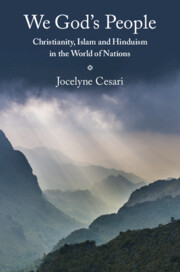Book contents
- We God’s People
- We God’s People
- Copyright page
- Dedication
- Epigraph
- Contents
- Figures and Tables
- Acknowledgments
- Note on Transliteration and Italicization
- Introduction
- 1 Framing the Question
- 2 State, Islam, Nation and Patriotism: Never-Ending Tensions
- 3 The Nexus of Secularism and Communalism, or Hinduism as a Political Project
- 4 Religion and the Transcendent State in China
- 5 Orthodoxy: Between Nation and Empire
- 6 Patterns of Religion-Politics Interactions
- Conclusion
- Bibliography
- Index
- References
Bibliography
Published online by Cambridge University Press: 11 December 2021
- We God’s People
- We God’s People
- Copyright page
- Dedication
- Epigraph
- Contents
- Figures and Tables
- Acknowledgments
- Note on Transliteration and Italicization
- Introduction
- 1 Framing the Question
- 2 State, Islam, Nation and Patriotism: Never-Ending Tensions
- 3 The Nexus of Secularism and Communalism, or Hinduism as a Political Project
- 4 Religion and the Transcendent State in China
- 5 Orthodoxy: Between Nation and Empire
- 6 Patterns of Religion-Politics Interactions
- Conclusion
- Bibliography
- Index
- References
Summary

- Type
- Chapter
- Information
- We God's PeopleChristianity, Islam and Hinduism in the World of Nations, pp. 372 - 421Publisher: Cambridge University PressPrint publication year: 2021

